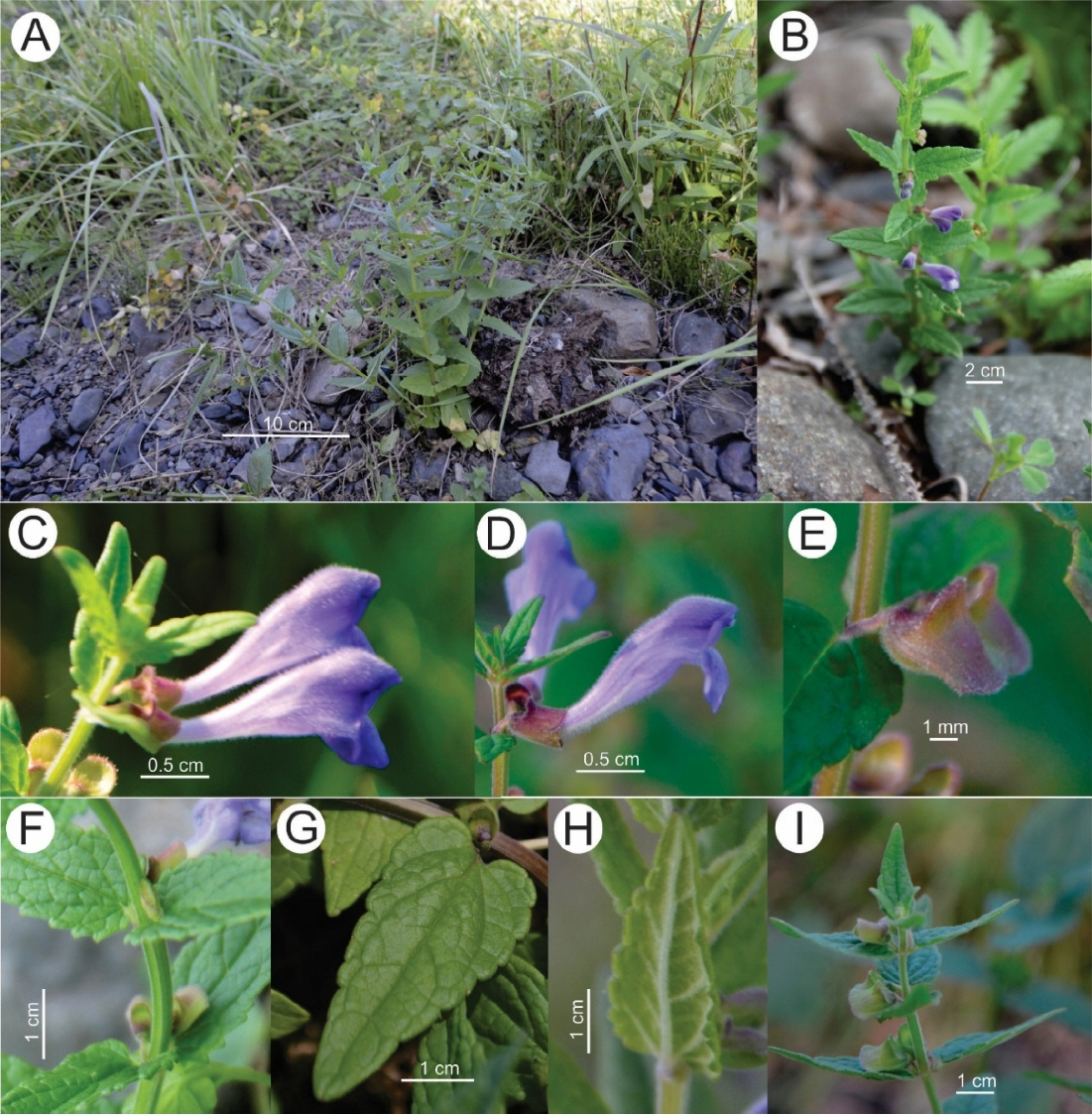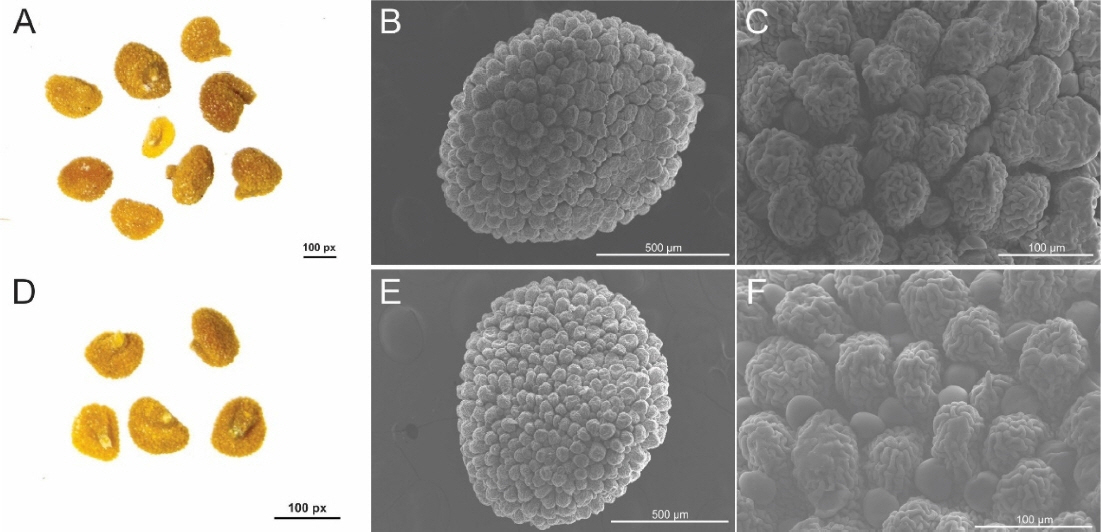/home/virtual/kjpt/journal//../xmls/kjpt-49-2-198.xml
BAZARRAGCHAA, BATDELGER, SHAGDAR, PAEK, and LEE: Scutellaria krasevii Kom. & I. Schischk. ex Juz. (Lamiaceae): a new record species from Mongolia
Abstract
We report Scutellaria krasevii Kom. & I. Schischk. ex Juz. (subfamily Scutellarioideae, family Lamiaceae) as a new recorded species of Mongolia. This species is morphologically similar to S. galericulata but can be differentiated by the presence of comparatively thick and triangular-cordate leaves having a heteromerously deep-crenate margin, a densely reclinate pubescent stem, and a densely pubescent corolla. A taxonomic description, a key to the genus in Mongolia, habit photographs, and scanning electron photomicrographs of nutlets are provided for species identification. We also present a table for a comparison of the diagnostic characteristics with those of related species. This species grows along the banks of the Unit river, Khutag-Undur soum, Bulgan province, Mongolia, approximately 2,300 km far away from the type locality in Russia.
Keywords: Scutellaria krasevii, S. galericulata, Lamiaceae, new record, Mongolia
The genus Scutellaria L., a member of subfamily Scutellarioideae (Lamiaceae), comprises more than 360 species and is distributed in the Irano-Turanion Region, the Mediterranean area, and the Andes ( Paton, 1990; Harley et al., 2004; Hasani-Nejad et al., 2009; Jamzad and Hasani-Nejad, 2014). The genus is characterized by its bilabiate calyx, unlobed lips, scutellum in the upper lip of calyx, and nutlets ( Harley et al., 2004).
Juzepczuk (1954) reported 148 species from Russia and treated them under three sections and 33 series. Later, Paton (1990) divided Scutellaria into two subgenera, subgen. Scutellaria (Neveski ex Juz.) Juz., consisting of five sections and subgen. Apelthanthus (Neveski ex Juz.) Juz., consisting of two sections. In accordance with his treatment, S. krasevii is included in the Scutellaria section of the subgenus Scutellaria.
Twelve taxa of Scutellaria have been reported in Mongolia ( Grubov, 1955, 1982; Gubanov, 1996, 1999; Darijma and Kamelin 2002). During a recent field visit to the Bulgan province, we collected a species of Scutellaria and it is identified it as Scutellaria krasevii Kom. & I. Schischk. ex Juz. with an intensive morphological investigation and survey of relevant literature and type specimen. Scutellaria krasevii is morphologically similar to S. galericulata. However, the former can be easily differentiated from the later by the presence a pubescent stem, triangular-cordate leaf, deep crenate margin, pubescent corolla, and mostly compound papillateglandular nutlet ( Table 1). The present study provides taxonomic descriptions, a key to the genus Scutellaria in Mongolia, habit photographs, and scanning electron photomicrographs of the nutlet surface structure ( Figs. 1, 2), based on plant materials collected from Mongolia.
Taxonomic Treatment
Scutellaria krasevii Kom. & I. Schischk. ex Juz. Bot. Mater. Gerb. Bot. Inst. Komarova Akad. Nauk S.S.S.R. 14: 357–358, 1951; Juzepczuk S. V., Flora of the USSR, 20: 92, 1954.–TYPE: Russia. East Far, Regio Primorsk, Vladivostok, Spasskyi region, Gaivoron village, 23 Jul 1927, I. Schischkin, 163 (lectotype: LE, not seen; syntype: LE; isosyntype: TK).
Herbs perennial, rhizome repent. Stems (15) 20–35 (40) cm tall; erect or sub erect, branched; densely crispus pubescent; continuously leafy and sometimes basally leaf dried. Petoile 2–3.5 mm; densely crispus pubescent. Leaves (1) 2–4 (4.5) cm long, (0.4) 0.5–1.7 (2) cm wide; bright green; triangularcordate, base cordate, apex acute, margin heteromerous deeply crenate, 4–9 dentate on each margin; adaxially sparsely reclinate hispidus hairy; abaxially pubescent, densely on veins. Inflorescence one-sided, non-bracts. Flowers axillary (2) 5–15 (17) pairs on apical part of stem. Pedicel (1) 1.5–2 (2.5) mm, densely retrorse pubescent. Calyx 2–4 mm, to 3.5–5 mm; larger and upper lip lost in fruiting; densely short hispidus hairy. Corolla violet-blue; densely pubescent outside; (1) 1.5–1.8 (1.9) cm long; upper lip much shorter than the lower ( Fig. 1). Nutlet yellow-orange, subovoid; nutlet surface rough, glabrous, mostly compound papillate with sessile glands ( Fig. 2A–C). Flowering June-August, fruiting July–September.
Distribution: Russia: Far East; Mongolia: Khangai forest mountain region.
Ecology and habitat: 50–60 individuals were found growing on a 100 m2 area of waterside pebbles beside the river in association with Equisetum pratense Ehrh., Plantago major L., Geranium pratense L., Epilobium palustre L., Thalictrum minus L., Chenopodium album L., Artemisia mongolica (Fisch. ex Besser) Fisch. ex Nakai, Mentha arvensis L., Inula britannica L., Agrimonia pilosa Ledeb., Sanguisorba officinallis L. and Stachys palustris L.
Specimens examined: MONGOLIA. Bulgan province: Unit River, Unit bag, Khutag-Undur soum, 49°17′280″N, 102°58′492″E, elev. 987 m, 23 Aug 2015, B. Badamtsetseg, 2015-686 (BTM2016.1.223); 24 Jun 2016, B. Badamtsetseg 2016-736 (BTM2019.2.1); 4 Jul 2017, B. Badamtsetseg 2017-706A (BTM2019.2.20).
Key for the genus Scutellaria in Mongolia
Notes: Gubanov ( 1996, 1999) recorded 11 Scutellaria taxa for the flora of Mongolia. Later, Scutellaria dependens Maxim. was added to this list by Darijma and Kamelin ( 2002). The present study reports Scutellaria krasevii as the 13th taxon in Mongolia. It is very interesting that the Russian Far East is the original distribution of this species, but it is also found in Mongolia, which is more than 2,300 km away from this region. This extended distribution record might help in prioritizing the conservation of this species in future.
ACKNOWLEDGMENTS
This study was sponsored by the Establishment of plant diversity information DB with voucher specimens project of the Ministry of Science and ICT, as (NRF-2017M3A9A5070202). It was also supported by Chungnam National University. Thanks are also due to the team of Mongolian Museum of Natural History for providing assistance in collecting and preserving the herbarium specimens.
Fig. 1.
Photographs of Scutellaria krasevii Kom. & I. Schischk. ex Juz. A. Habit. B. Flowering branch. C. Side view of the inflorescence. D. Flower. E. Mature calyx with scutellum in fruiting. F. Stem. G. Leaf (adaxial surface). H. Leaf (abaxial surface). I. Fruiting branch. 
Fig. 2.
Nutlet images of Scutellaria krasevii and Scutellaria galericulata. A–C. Scutellaria krasevii. D–F. Scutellaria galericulata. 
Table 1.
Diagnostic characters between Scutellaria krasevii and S. galericulata.
|
Morphological characters |
S. krasevii Kom. & I. Schischk. ex Juz. |
S. galericulata L. |
|
Stem |
Densely reclinate pubescent |
Glabrous or angles sparsely pubescent |
|
Leaf blade |
Triangular-cordate, rather thick |
Oblong-lanceolate, membranous to papery |
|
Leaf margin |
Heteromerous deeply crenate |
Regular obtusely crenate |
|
Corolla |
Densely pubescent outside |
Glandular hairy outside |
|
Nutlet morphology |
Mostly compound papillate-glandular, 1.5 × 1.22 mm |
Mostly single papillate-glandular, 1.6 × 1.24 mm |
Literature Cited
Darijma, Sh and Kamelin, RV. 2002. Novie vidi dlya flory Mongolii I otdelnikh ikh raionov. In Proceedings of International Conference on Biodiversity of Mongolia. Ulaanbaatar: 21-23 (in Russian).
Grubov, VI. 1955. Conspectus of Flora of the Mongolian People’s Republic. Proceedings of Mongolian Commission of the USSR Academy of Sciences, version 7. 283-284 (in Mongolian).
Grubov, VI. 1982. Opredelitel’ sosudistych rastenij Mongolii (s atlasom). Nauka, Leningrad. 213-214 (in Russian).
Gubanov, IA. 1996. Conspectus of Vascular Plants of Mongolia. Valang, Moscow. 87-90 (in Russian).
Gubanov, IA. 1999. Dopolneniya i ispravleniya k “Konspektu Flory Vneshnei Mongolii (Sosudistye Rasteniya)”. Turczaninowia 2: 19-23 (in Russian).
Harley, RM. Atkins, S. Budantsev, AL. Cantino, PD. Conn, BJ. Grayer, R. Harley, MM. De Kok, RD. Krestovskaja, TD. Morales, R. Paton, AJ. Ryding, O and Upson, T. 2004. Labiatae. In The Families and Genera of Vascular Plants. 7: Flowering Plants, Dicotyledons. Kubitzki, K. Kadereit, JW (eds.), Springer, Berlin. 167-275.
Hasani-Nejad, M. Jamzad, Z and Yousefi, M. 2009. Nutlet micromorphology in Scutellaria L. (Lamiaceae) in Iran. Iranian Journal Botany 15: 227-239.
Jamzad, Z and Hasani-Nejad, M. 2014. Taxonomic implications of pollen exine morphology in infrageneric classification of Scutellaria (Lamiaceae). Nordic Journal of Botany 32: 233-244.  Juzepczuk, SV. 1954. Scutellaria L. In Flora of the USSR. 20: Shishkin, BK. Juzepczuk, SV (eds.), Izdatel’stvo Akademii Nauk SSSR, Moskva. 50-150 (in Russian).
Paton, A. 1990. A global taxonomic investigation of Scutellaria (Labiatae). Kew Bulletin 45: 399-450. 
|
|













